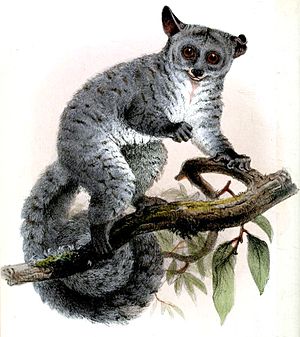Giant silver galago
| Giant silver galago | ||||||||||||
|---|---|---|---|---|---|---|---|---|---|---|---|---|

Giant Silver Galago ( Otolemur monteiri ) |
||||||||||||
| Systematics | ||||||||||||
|
||||||||||||
| Scientific name | ||||||||||||
| Otolemur monteiri | ||||||||||||
| Bartlett , 1863 |
The silver giant galago ( Otolemur monteiri ) is a primate species from the Galagos family (Galagonidae). It is controversial whether it is a separate species or a subspecies of the large-eared giant galago .
features
Silver giant galagos are similar to the big-eared giant galagos, but differ in the eponymous coat color and in the morphology of the penis . In the western subspecies O. m. monteiri , the fur is silver-gray on the upper side and yellowish-white on the belly, the eastern subspecies O. m. argentatus is slightly darker, the paws are black and the tail is often whitish. In this subspecies, black flies are common. The fur of these animals is dense and woolly, the tail very bushy and longer than the body. As in all Galagos, the head has large eyes and ears.
distribution and habitat
Giant silver galagos are native to Africa , their range extends from Angola to Kenya and Tanzania . However, the exact dimensions of the distribution area are unclear, also due to the unclear demarcation from the large-eared giant galago. The habitat of these animals are predominantly the dry Miombo forests and other tree-covered areas.
Way of life
These primates are nocturnal tree dwellers who mainly move four-legged through the branches and, in contrast to many other Galagos, hardly jump. Little is known about social behavior; the animals go in search of food on their own. The food consists of fruits, tree sap and insects, but the composition of the food varies according to region and season.
Danger
Giant silver galagos are widespread and common, with no known acute threats. The IUCN , which regards them as a subspecies of the giant big-eared galagos, lists them as "not endangered" ( least concern ).
literature
- Thomas Geissmann : Comparative Primatology. Springer-Verlag, Berlin et al. 2002, ISBN 3-540-43645-6 .
- Don E. Wilson, DeeAnn M. Reeder (Eds.): Mammal Species of the World. A taxonomic and geographic Reference. Johns Hopkins University Press, Baltimore MD 2005, ISBN 0-8018-8221-4 .
Web links
- Information at theprimata.com
- Otolemur crassicaudatus ssp. monteiri in the endangered Red List species the IUCN 2008 Posted by: S. Bearder, 2008. Accessed on 10 second in 2009.
